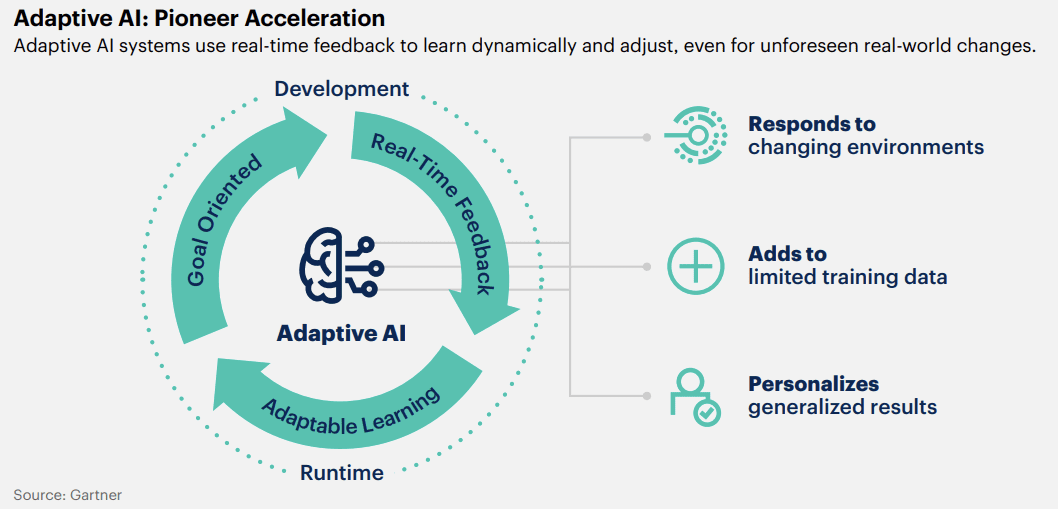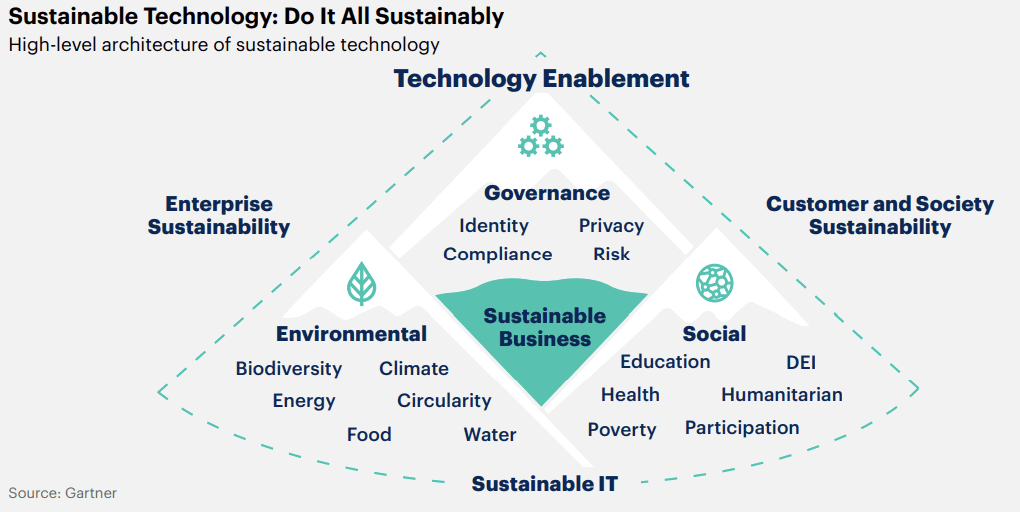With the current economic climate, business leaders are facing an even greater challenge to plan and commit to crucial strategies. Gartner’s annual list of key technology trends provides a necessary guide through the unstable future to help enterprises identify strategies that can help them flow with the changing tides. This list can help businesses to stay on top of technological advancements over the next three years and beyond.
Knowing what technological investments can benefit your enterprise can help you take strides toward post-pandemic growth more confidently.

Read on to get an overview of the trends and how enterprises can benefit from them.
1. Digital Immune System
A digital immune system (DIS) is a combination of practices and technologies that help make products, services, and systems more resilient. These practices and technologies leverage observability, artificial intelligence (AI)-augmented testing, chaos engineering, auto-remediation, site reliability engineering, and software supply chain security.
A DIS helps you plan for risks and learn from failures so that you can create a better customer experience that can withstand failure.
By 2025, organizations investing in building digital immunity will increase customer satisfaction by decreasing downtime by 80%.

A DIS can help you invest in practices to make business-critical systems better and stronger. Creating and growing a DIS makes businesses more resilient overall and creates value for both business and IT stakeholders. It helps you connect software development to business outcomes and support customer experience strategies using modern technologies and practices.
2. Applied Observability
Applied observability is the use of data that can be observed in a coordinated way across different parts of a business, like applications, infrastructure, and operations, to make decisions quickly and proactively and plan for future business needs.
Applied observability helps businesses make better decisions in the future. By using this method, you can reduce the time it takes to respond and optimize business operations in real-time.
By 2026, 70% of organizations that applied observability will be able to make decisions faster, which will give them an advantage over their competitors.

Your observable data is your most precious asset. Focus on identifying business capabilities and use cases from active and passive metadata to get an advantage over your competition. This will help you to plan multiple concurrent observability initiatives.
Make decisions quickly by changing the focus of the organization from monitoring and reacting to applying observability.
Help people in your organization adopt applied observability by focusing on the spectrum of business, application, and infrastructure layers.
3. AI Trust, Risk and Security Management (AI TRiSM)
AI needs different types of trust, risk, and security than you have used before. AI TRiSM makes sure that models are reliable, trustworthy, secure, and private.
AI TRiSM helps ensure better results when adopting AI, including achieving business goals and user acceptance. It does this by supporting AI model governance, trustworthiness, fairness, reliability, robustness, efficacy, and privacy. It provides solutions, techniques, and processes for model interpretability and explainability as well as AI privacy, model operations, and resistance to adversarial attacks.
By 2026, organizations that operationalize AI transparency, trust, and security will achieve a 50% result improvement in their AI models in terms of adoption, business goals, and user acceptance.

4. Industry Cloud Platforms
Industry clouds bring together cloud services that are traditionally purchased separately by combining them into one pre-integrated, customizable solution. This can help organizations be more agile, speed up innovation, and accelerate time to value.
Industry cloud platforms are a combination of software, platform, and infrastructure as a service (IaaS) with specific functionality for an industry. This can help businesses more easily adapt to changes in their industry.
Enterprises can use the packaged business capabilities (PBCs) of industry cloud platforms to create digital initiatives that are unique and differentiating. This provides agility, innovation, and reduced time to market, and also avoids lock-in.
By 2027, over 50% of enterprises will use industry cloud platforms for accelerating their business initiatives.
5. Platform Engineering
Companies have started to build platforms that sit between the user and the services they rely on. This helps developers, data scientists, and end users by reducing friction for the valuable work they do.
Platforms are a collection of tools, capabilities, and processes that experts have put together. The goal is to make it easy for users to find what they need so they can be productive and not waste time trying to figure things out. The platform should be presented in a way that makes it easy for the users to follow their preferred workflow.
80% of software engineering organizations will form platform teams by 2026, as internal providers of reusable services, components, and tools for application delivery.
6. Wireless-Value Realization
Multiple wireless technologies working together will provide a more efficient, reliable, and scalable system that reduces how much money companies have to spend on it. This promotes the future of more wireless usage, different types of protocols, and a wider range of capabilities that support digital business.
Wireless-value realization means that wireless technology is not just for communication anymore. It can be used for other things like edge devices and digital tagging solutions. This means that there will be a lot of different types of wireless technologies to cater to different environments.
Networks will become a source of business value as wireless technology is becoming a platform for innovation instead of just a way to communicate.
Up from less than 15%, by 2025, 50% of enterprise wireless endpoints will use networking services that deliver additional capabilities beyond communication.

7. Superapps
A superapp is an app that has a lot of features and also gives users access to other smaller apps. Superapps are built so people can have a consistent and personalized experience using the app.
Users can find and use their own set of apps within the superapp, which makes for a digital experience that is tailored to them and fits the context of what they are doing.
Over 50% of the global population will be daily active users of multiple superapps by 2027.
To make superapps more effective, design them to be people-centric. You need to identify the features that will be most used and engage with end users to get feedback. Also, offer a business model and resources that will be beneficial for development partners. Make it easy for developers to build miniapps and submit them for potential monetization.
Establish security and data protection requirements for miniapps by creating ecosystem governance reinforced with shared platform capabilities.
8. Adaptive AI
Adaptive AI helps you get value from AI and keep it aligned with your goals in real-time. The value of operationalized AI is the ability to rapidly develop, deploy, adapt and maintain AI across different environments in the enterprise.
With the complexity of engineering and the demand for faster production times, it is important to have less rigid AI engineering pipelines or to build AI models that can adapt on their own in production.
By 2026, enterprises adopting AI engineering practices to build and manage adaptive AI systems will perform better than their peers in operationalizing AI models by at least 25%.
Adaptive AI systems can change how they behave after they have been deployed. They learn from experience and can adapt to changing conditions in the real world.

9. Metaverse
Metaverse is a combination of different technologies that are projected to provide new opportunities and challenges to organizations in different industries. Organizations are developing ways to use virtual workspaces and internal metaverse experiences (intraverses) to provide better engagement, collaboration, and connection to their employees.
By 2027, more than 40% of large organizations across the world will be using a combination of Web3, spatial computing, and digital twins in metaverse-based projects for increasing revenue.

10. Sustainable Technology
Sustainable technology is a set of solutions that makes IT services more energy and material efficient; lets businesses be sustainable through technologies like traceability, analytics, renewable energy, and others; and helps customers become more sustainable through apps, software, marketplaces, and more.
By 2025, 50% of CIOs will have performance metrics aligned with the sustainability of the IT organization.

These insights can help business leaders who want to stay on top of technological advancements and enable them to be prepared for the future by investing in these technologies to gain a competitive edge in uncertain times.
Source: Gartner
Read next: 17 key technology trends that companies can expect to see in 2023










